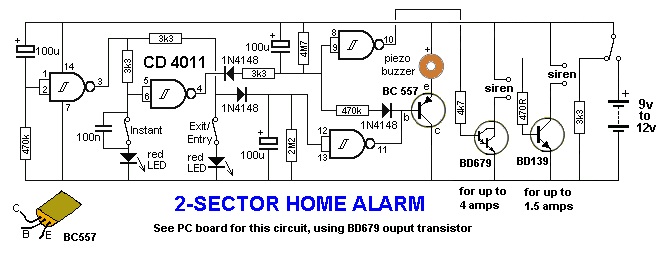The alarm keeps wailing if the door is kept open. It only turns off after 5-10 minutes when the door is opened and closed. The two door switches trigger the alarm as an Instant or Delayed input and these switches can be purchased from any alarm supplier. These switches can be reed switches that are Normally Open and the contacts close when the magnet is near. The switch can also be a “pin switch” that fits in a hole in the door and has a long pin that gets pushed into the switch when the door is closed.
Both switches must be closed for the alarm to “arm itself.” If a switch is opened and then closed, the siren will wail instantly via the Instant switch.

The CD4011 is a quad 2-input NAND gate. The first gate (pins 1, 2 and 3) is a timer and the output does not go HIGH until the 100u charges via the 470k. This is the Exit/Entry delay. When it goes HIGH, the two LEDs are turned ON via the 3k3 resistors. This arms the alarm.
Gate “B” (pins 5, 6 and 4) is an inverter that detects when the Instant input is broken and it charges the 100u via the 3k3 resistor. Gate “C” (pins 8, 9 and 10) detects the charge on the 100u and turns on the output transistor via the 4k7 or 470R resistor. The Instant switch can be closed after a second as it has done its job of charging the top 100u via the 3k3 resistor. The circuit is now activated and the siren starts wailing. The 100u and 4M7 provide the 5-10 minutes timer for the “wailing.”
The 100u and 2M2 provide the timer for the buzzer when you enter. It will buzz for 20 seconds then turn off as the entry door has opened and closed and charged the lower 100u.The 1N4148 only allows the circuit to charge the 100u and when the door is closed, the voltage on the anode lead drops to a low value but the diode does not allow the 100u to discharge – it only discharges via the 2M2. If the Exit/Entry door is left open, the main siren will wail after 45 seconds. Gate “D” (pins 12, 13 and 11) detects the voltage on the lower 100u and turns ON the buzzer. The input of the gate puts no load on the 100u (as it has a very high impedance) and it is discharged via the 2M2.
 The piezo buzzer can be a 5v device and a 100R resistor can be used in series with one lead to reduce the volume.
The piezo buzzer can be a 5v device and a 100R resistor can be used in series with one lead to reduce the volume.
The output transistor can be a Darlington BD679 for up to 4 amp load or a BD139 with 470R base resistor for 1.5Amp load.
Terminal blocks are used for all the external connections to make the alarm easy to install.
The PC board and a full kit of components is available for this project from your local kit supplier.
Email Colin Mitchell: talking@tpg.com.au for the address of your local kit supplier.







